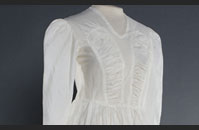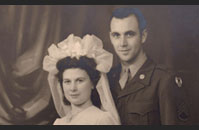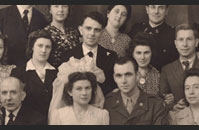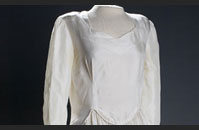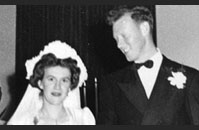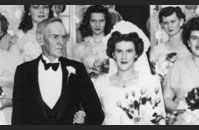Posts Tagged ‘Dinner with a Curator’


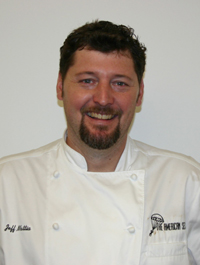
Visitors to The National WWII Museum expect to see artifacts and exhibits, but they are often surprised to find a very delicious history lesson where they least expect it – in the Museum’s American Sector Restaurant and on-site Soda Shop. Both venues harken back to the war years with decor and atmosphere, but often the food is part of the history too. Award-winning Chef John Besh and Executive Chef Jeffrey Mattia find their inspiration in the staples of American food and the influences the war had on bringing global cuisine back to America with the returning troops.
Recently Mattia was named a finalist in the Gambit Weekly Emerging Chefs Challenge. He will compete with 11 other rising stars in the culinary world for the title on August 28, 2013, and we will be there cheering him on!
You can sample the Chef’s work daily at the American Sector (11 am-9 pm) and the Soda Shop (7 am-5:30 pm) or as part of our monthly Dinner with a Curator Series, pairing presentations by Museum staff on a wide array of topics related to WWII with a specially “curated” three-course meal.
Tuesday, August 20, 2013
Eric Rivet presents “Star Wars: WWII in a Galaxy Far, Far Away,” 6:30 pm – 8:30 pm
Although the Star Wars movies present a futuristic galaxy of space combat and laser guns, nearly all of the weapons and many of the props used in the original trilogy are World War I and World War II firearms and field equipment. The National WWII Museum has examples of most of these weapons in its collection, including the types of guns carried by Han Solo and Boba Fett and the lightsaber used by Luke Skywalker. Join Curator Eric Rivet for a discussion of the weapons and equipment used in the Star Wars films and see them for yourself.
Purchase tickets for Dinner with a Curator.
About Chef Jeffrey Mattia
Jeff Mattia is the Executive Chef at American Sector, the John Besh restaurant in The National WWII Museum. Growing up in Connecticut, his passion for cooking started at a young age when he would accompany his grandfather on fishing trips on Long Island Sound. Following high school, Jeff joined the United States Marine Corps, during which he had the opportunity to travel the Mediterranean region and learn about their cuisine. Following his service, Jeff returned to the United States and enrolled in Johnson & Wales University to complete their culinary arts degree program. After graduating, he worked at several prestigious restaurants in the Northeast, before moving to New Orleans with his family in 2010, where he had taken a position at Restaurant August as executive sous chef. Jeff became the sous chef at American Sector in the summer of 2011, and was named executive chef in 2012.
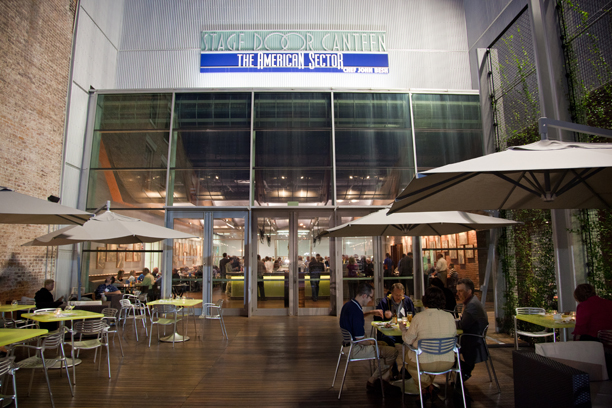



The World War II years challenged civilians from the Home Front to war-torn Europe to do without many things for the sake of victory. The war also encouraged creativity to fill the gaps left by rationing and the ravages of war. These wedding dresses are a testament to the inventiveness of women tying the knot during the lean war years, and are beautifully made with materials such as parachute silk and mosquito netting.
Myrtille Delassus’ Parachute Silk Wedding Gown:
Myrtille Delassus was seventeen when the Germans invaded her hometown of Merville, France. She spent four long years waiting in ration lines, cold and perpetually hungry. She could hear the Allied invasion of Normandy and, like many others, welcomed British and American soldiers when they arrived in Merville.
GIs were generous with their surplus supplies, and one soldier, Sgt. Joseph Bilodeau of Corinth, New York, often gave items to Madame Cocque, the owner of a dress shop across the street from where he was stationed. One evening, Madame Cocque invited Sgt. Bilodeau to dinner to thank him. Since it would appear inappropriate for her to dine alone with him, she invited Myrtille, who worked in her shop. Myrtille and Joseph enjoyed each other’s company and started dating. They were married six months later on October 15, 1945, at the church in Merville.
Myrtille’s wedding dress was made from a silk parachute by the women in Madame Coque’s dress shop. It features a classic silhouette with a double-rouched bodice and medium length train.

Joyce Adney’s Parachute Silk Wedding Gown:
Joyce Adney and Adrien Reynolds met at a dance at Utah State University, where Joyce was head of the student USO and Adrien was training to be a radar operator. The newly minted marine made quite an impression on Joyce. She later recalled, “After we had gone through the receiving line and had punch, we went into the hall and we danced together all evening. He walked me home and I went in and told my roommate I had met the man I was going to marry.”
Adrien and his detachment shipped out with the 4th Marine Division to invade the island of Saipan on June 15, 1944. Once combat ended nearly a month later, Adrien and his fellow marines found several unused Japanese cargo parachutes while clearing caves. He sent one of the parachutes to Joyce for safekeeping.
Adrien was discharged shortly after his participation in the bloody Battle of Okinawa. After stopping home in New Orleans, he immediately went to see Joyce, who was working towards her master’s degree in Detroit. “I went out to the airport, and it had been almost three years since I had seen him. He was the last one off the plane wearing his dress blues, and he melted my heart into a little puddle.” Little did Joyce know that in the pocket of those dress blues was her engagement ring.
Due to the continuation of rationing, Joyce opted to have her wedding gown made from the Japanese parachute silk Adrien had sent home. Joyce’s mother, living in Utah, made the gown by hand. Joyce would wrap strings around herself to measure her waist and bust, and then send the strings to her mother, who would then lay the strings out and sew the fabric accordingly. Adrien’s father contributed as well, making heart-shaped tins for their five-tier cake. The couple was married March 27, 1946, and remained so for the rest of their lives.

Dinner with a Curator
Toni Kiser presents “War Time Weddings”
Tuesday, June 25, 2013
6:30 pm – 8:30 pm
The Stage Door Canteen at The National WWII Museum
June has been a traditional month for weddings since the Middle Ages. This June, Toni Kiser, Assistant Director of Collections & Exhibits/Registrar, will talk about WWII-era weddings. Learn how many brides still managed to have gorgeous gowns and delicious cakes, despite the rationing of silk and sugar. Hear a few stories of love that kept men and women going through the war, and see the artifacts related to these love stories and weddings.
View the Full Menu
Purchase Tickets






